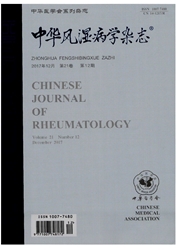

 中文摘要:
中文摘要:
目的了解弥漫增生型狼疮肾炎(LN)患者趋化因子MCP-1、CCL19、CXCL9、CXCL10和趋化因子受体CCR2、CCR7、CXCR3的表达,探讨趋化因子及其受体在LN发病中的作用。方法①同步收集12例弥漫增生型LN患者肾组织和外周血,抽提总RNA并反转录为eDNA,以实时荧光定量聚合酶链反应(PCR)方法检测趋化因子基因MCP-1、CCL19、CXCL9、CXCL10和趋化因子受体基因CCR2、CCR7、CXCR3的表达水平。②应用免疫荧光抗体标记、激光扫描共聚焦显微镜技术观察患者肾组织趋化因子MCP-1、CCL19、CXCL9和CXCL10的表达。结果弥漫增生型LN患者趋化因子基因MCP-1、CCL19、CXCL9和CXCL10mRNA在肾脏组织和外周血的表达呈同步增高趋势,4种趋化因子蛋白在肾小球的表达显著增高。趋化因子受体CCR2和CXCR3在LN患者外周血高表达。结论趋化因子MCP-1、CCL19、CXCL9和CXCL10外周血表达水平可能做为评估狼疮患者肾脏病变的生物学标记。阻断趋化因子与其相应受体的结合将可能减轻患者的临床症状、改善预后。
 英文摘要:
英文摘要:
Objective To explore the role of chemokines and chemokine receptors in the etiopathogenesis of diffuse proliferative lupus nephritis (LN). Methods ① Total RNA from the kidney tissue, and peripheral blood cells of 12 patients with diffuse proliferative LN and 10 normal controls were prepared simultaneously and reverse transcribed into complementary DNA. Sybr green dye based real-time quantitative PCR method was used to compare the expression levels (indicated as-AACt value) of MCP-1, CCL19, CXCL9, CXCL10 and CCR2, CCR7, CXCR3. ② Immunofluorescece labeling and immunohistochemical staining technique were used to observe the distribution of chemokines MCP-1, CCL19, CXCL9 and CXCL10 in normal and patients kidney tissues. Results The 4 chemokines genes (MCP-1, CCL19, CXCL9 and CXCL10) were consistently highly expressed in kidney tissues and peripheral blood cells of diffuse proliferative LN patients compared with normal controls. The 2 chemokine receptors, CCR2 and CXCR3 were also overexpressed in peripheral blood cells of diffuse proliferative LN patients. There was nearly no expression of these 4 chemokine proteins in normal kidneys. But they were found in glomeruli of diffuse proliferative LN patients. Conclusion The expression of chemokines in the peripheral blood cells may be used as biomarkers for LN. Further study maybe lead to the development of specific drugs targeting at them for the treatment of systemic lupus erythematosus (SLE).
 同期刊论文项目
同期刊论文项目
 同项目期刊论文
同项目期刊论文
 期刊信息
期刊信息
